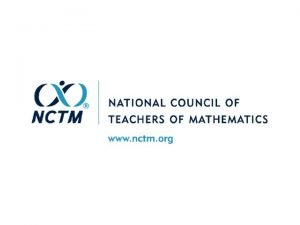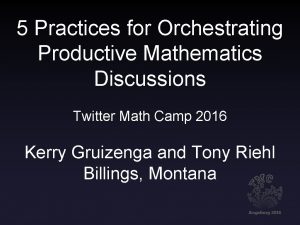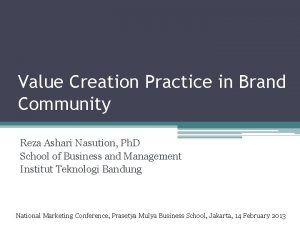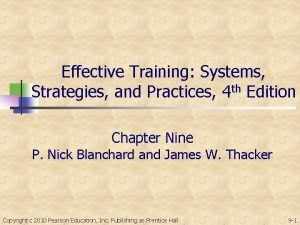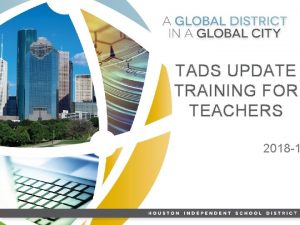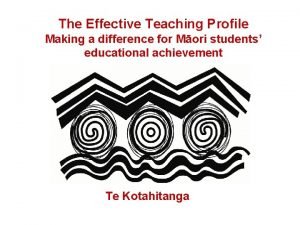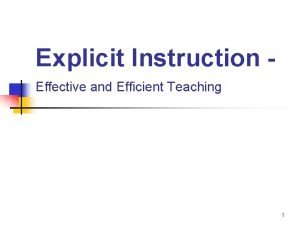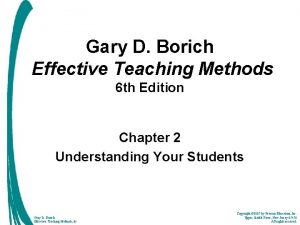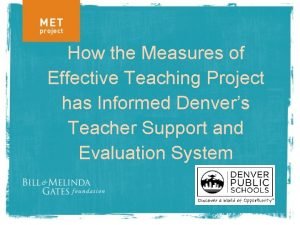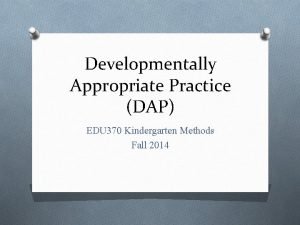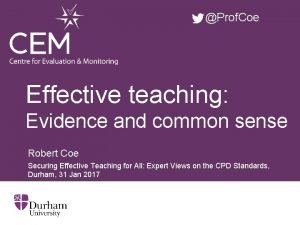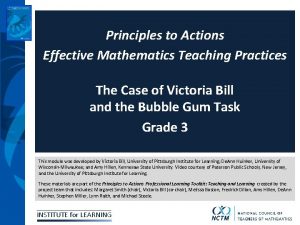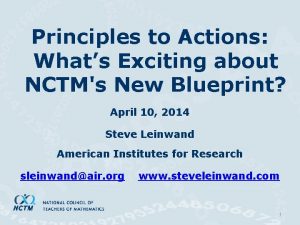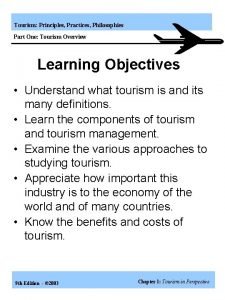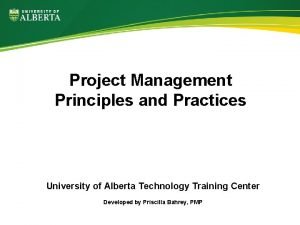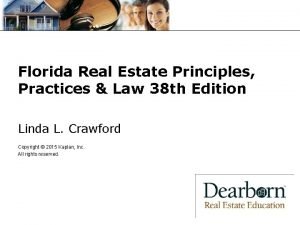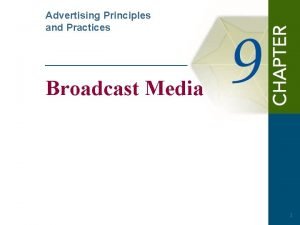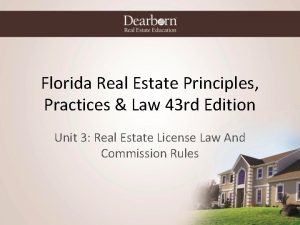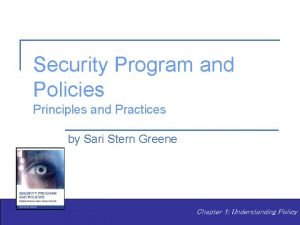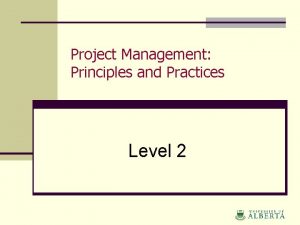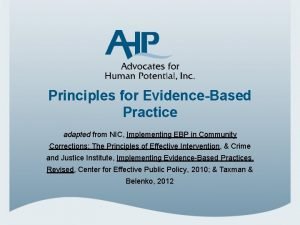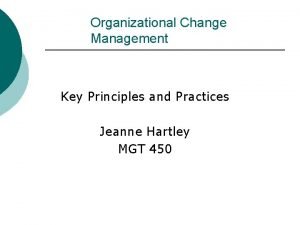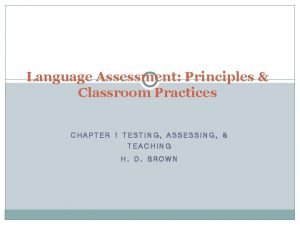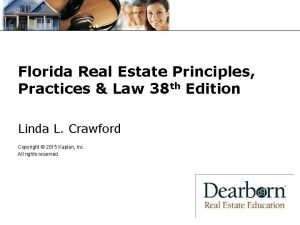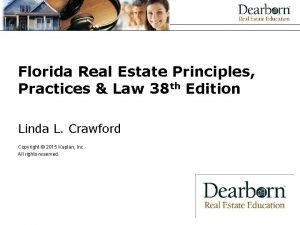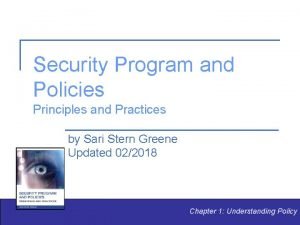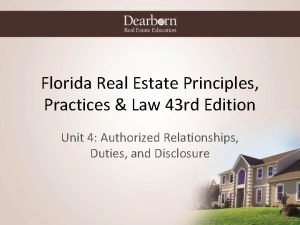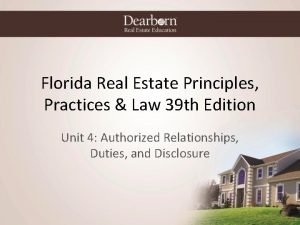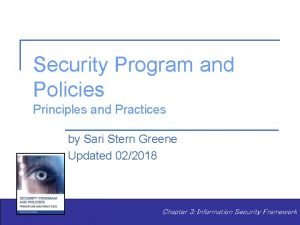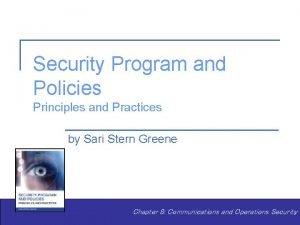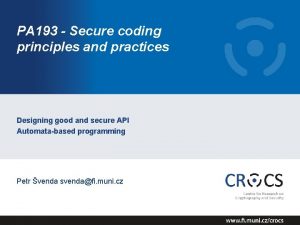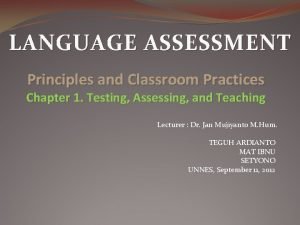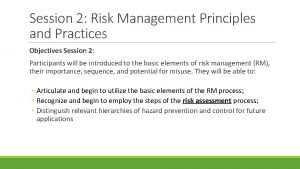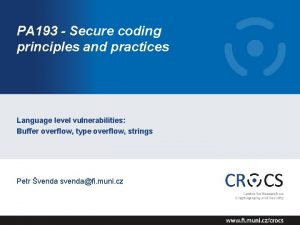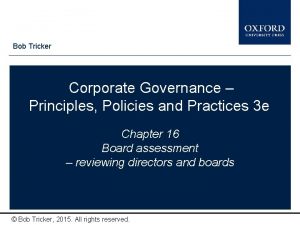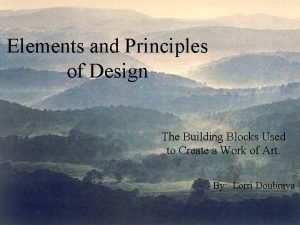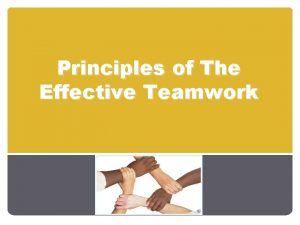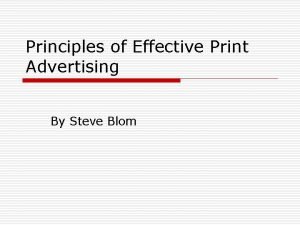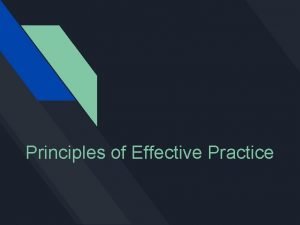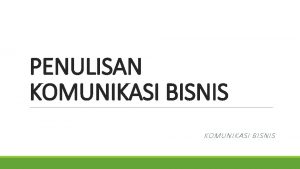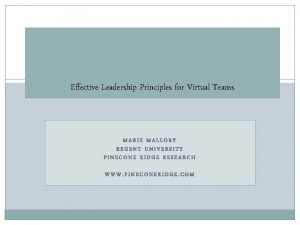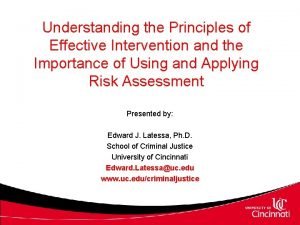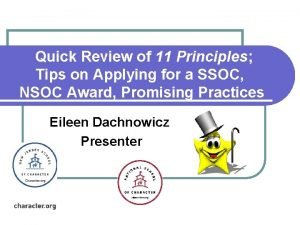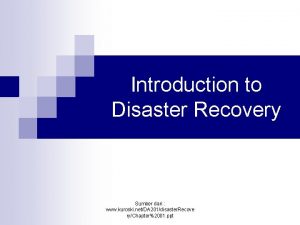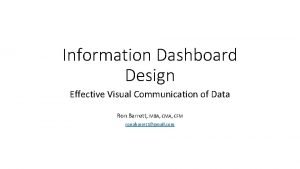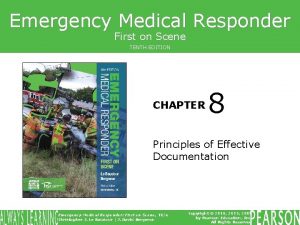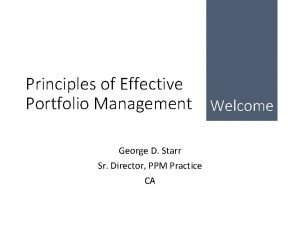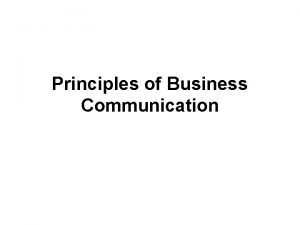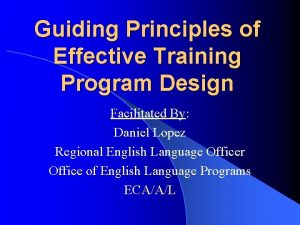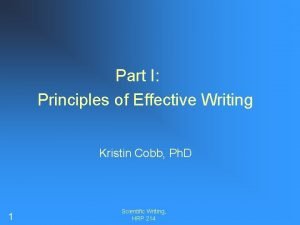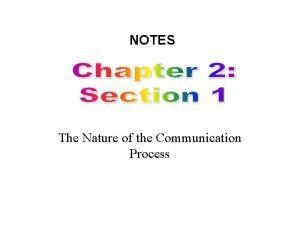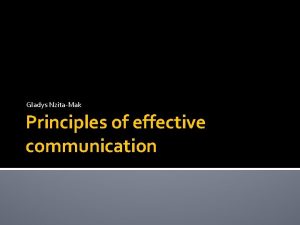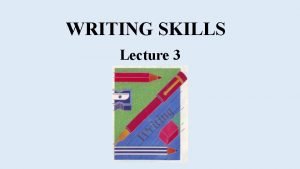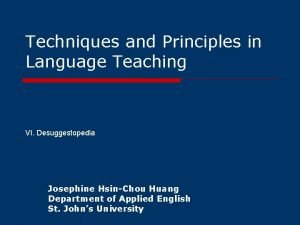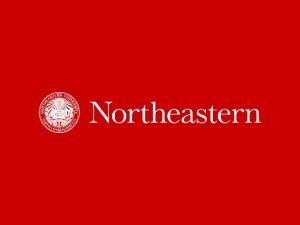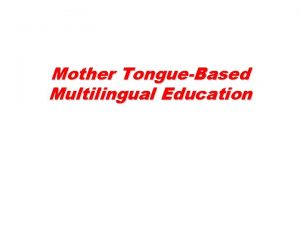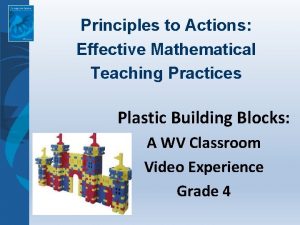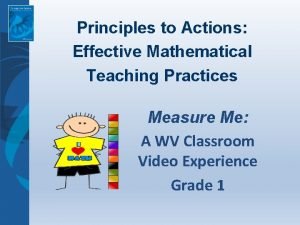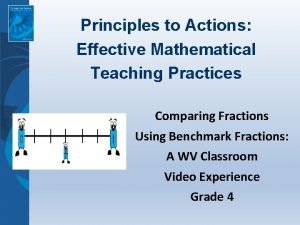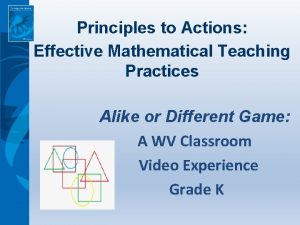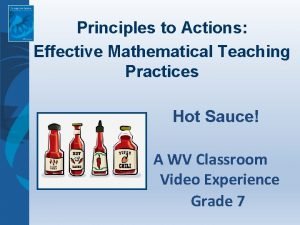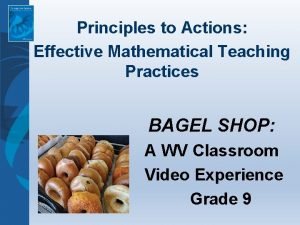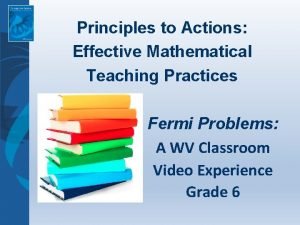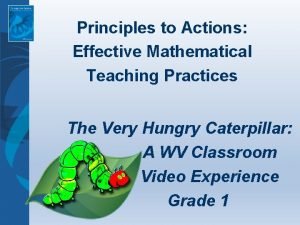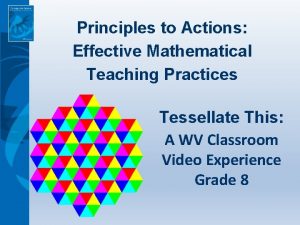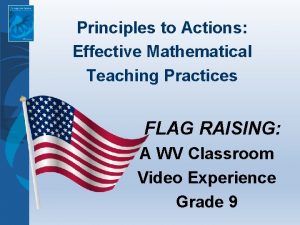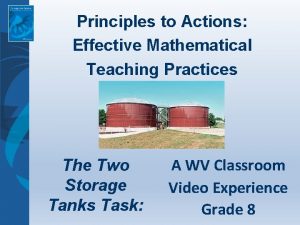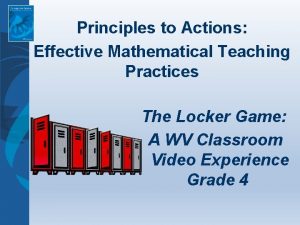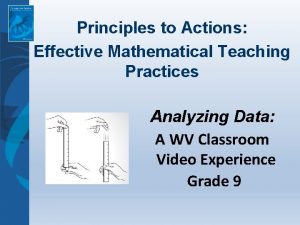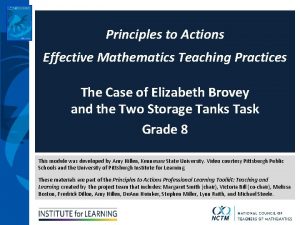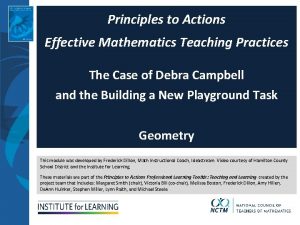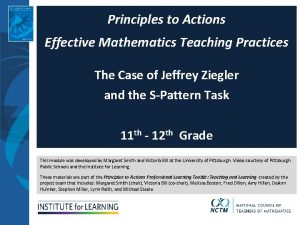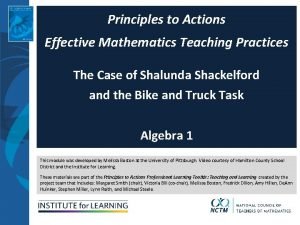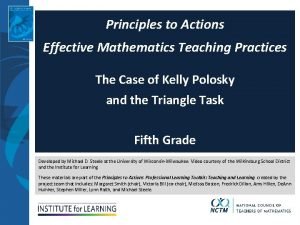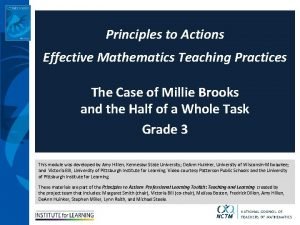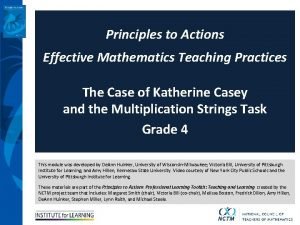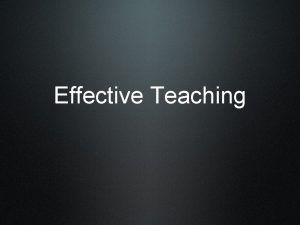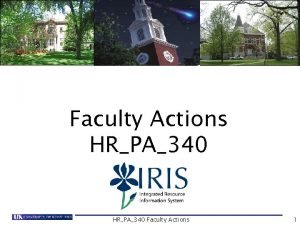Principles to Actions Effective Mathematical Teaching Practices Create
































































- Slides: 64

Principles to Actions: Effective Mathematical Teaching Practices Create Your Own Trail Mix: A WV Classroom Video Experience Grade 9

PLEASE STAND UP IF:

A 25 -year History of Standards-Based Mathematics Education Reform

A 25 -year History of Standards-Based Mathematics Education Reform 2014 Principles to Actions: Ensuring Mathematical Success for All The overarching message of Principles to Actions is that effective teaching is the nonnegotiable core necessary to ensure that all students learn mathematics.

WV College- and Career. Readiness Standards for Mathematics (2016) The West Virginia Collegeand Career-Readiness Standards for Mathematics define what students should understand be able to do in their study of mathematics. However, the Standards do not describe or prescribe the essential conditions required to make sure mathematics works for all students.

Although We Have Made Progress, Challenges Remain • The average mathematics NAEP score for eighth grade students has been essentially flat since 2009. • Among 79 countries participating in the 2018 Programme for International Student Assessment (PISA) of 15 -year-olds, the U. S. ranked 37 th in mathematics. • Significant learning differentials remain.

Teaching and Learning Principle “An excellent mathematics program requires effective teaching that engages students in meaningful learning through individual and collaborative experiences that promote their ability to make sense of mathematical ideas and reason mathematically. ” Principles to Actions (NCTM, 2014, p. 7)

Beliefs About Teaching and Learning Mathematics - Activity DIRECTIONS In a group or with a partner: 1. Open the packet and remove the cards. 2. Find the header cards: Productive and Unproductive. Place these cards on the table. 3. Each of the remaining cards identifies a belief about teaching and learning. Read each of the belief cards. 4. Identify which belief cards are Productive and which belief cards are Unproductive. 5. Place each belief card under the header card to which it was matched. 6. Be prepared to defend your decisions.


We Must Focus on Instruction • Student learning of mathematics “depends fundamentally on what happens inside the classroom as teachers and learners interact over the curriculum. ” (Ball & Forzani, 2011) • Teaching has 6 to 10 times as much impact on achievement as all other factors combined…Just three years of effective teaching accounts on average for an improvement of 35 to 50 percentile points. ” (Schmoker , 2005)

Effective Mathematics Teaching Practices 1. Establish mathematics goals to focus learning. 2. Implement tasks that promote reasoning and problem solving. 3. Use and connect mathematical representations. 4. Facilitate meaningful mathematical discourse. 5. Pose purposeful questions. 6. Build procedural fluency from conceptual understanding. 7. Support productive struggle in learning mathematics. 8. Elicit and use evidence of student thinking.

Effective Mathematics Teaching Practices Look Fors

WV Classroom Video – Create Your Own Trail Mix Overview Students generate a mathematical model of a system of inequalities in two variables with a familiar product – trail mix. Upon successful task completion, students will: • Interpret inequalities and graphs • Choose variables, specify constraints, and write inequalities to create a mathematical model of a situation – creating their own trail mix

A Closer Look Effective Mathematics Teaching Practice: Establish Mathematics Goals to Focus Learning

Establish Mathematics Goals to Focus Learning Goals should: • Clearly state what it is students are to learn and understand about mathematics as the result of instruction. • Be situated within learning progressions. • Frame the decisions that teachers make during a lesson.

Establish Mathematics Goals to Focus Learning Formulating clear, explicit learning goals sets the stage for everything else. (Hiebert, Morris, Berk & Janssen, 2007)

WATCH VIDEO NCTM Principles to Action: Establish Mathematics Goals to Focus Learning Video

Establish Mathematics Goals to Focus Learning

Create Your Own Trail Mix Lesson Alignment to the West Virginia College- and Career. Readiness (WVCCR) Standards M. 1 HS. 7 / M. A 1 HS. 7 Represent constraints by equations or inequalities, and by systems of equations and/or inequalities, and interpret solutions as viable or non-viable options in a modeling context. (e. g. , Represent inequalities describing nutritional and cost constraints on combinations of different foods. ) Instructional Note: Limit to linear equations and inequalities. M. 1 HS. 11 / M. A 1 HS. 17 Graph the solutions to a linear inequality in two variables as a half-plane (excluding the boundary in the case of a strict inequality) and graph the solution set to a system of linear inequalities in two variables as the intersection of the corresponding half-planes. M. 1 HS. 2 / M. A 1 HS. 2 Define appropriate quantities for the purpose of descriptive modeling. Instructional Note: Working with quantities and the relationships between them provides grounding for work with expressions, equations and functions.

WV Classroom Video – Create Your Own Trail Mix Goals to focus learning should be written in student-friendly language Upon successful completion, students will be able to: • Define the constraints in a situation • Create a mathematical model, presented in inequalities and graphs, that represents a situation

Establish Mathematics Goals to Focus Learning 1. Why is it important to establish math expectations for student learning? 2. In what ways will the math goals focus the teacher’s interactions with students throughout the lesson?

A Closer Look Effective Mathematics Teaching Practice: Implement Tasks That Promote Reasoning and Problem Solving

Implement Tasks That Promote Reasoning and Problem Solving Mathematical tasks should: • Provide opportunities for students to engage in exploration or encourage students to use procedures in ways that are connected to understanding concepts • Build on students’ current understanding and experiences • Have multiple entry points • Allow for varied solution strategies

Why Are Tasks So Important? Mathematical tasks : • Represent the meat of instruction • Are how we engage students and support the development of mathematical understanding • Connect learning goals to the actual classroom opportunity to learn • Use procedures to get answers to simple problems BUT are opportunities to develop deeper and broader understanding and application of mathematics

What Makes a GOOD Task? GOOD Mathematical Tasks Are: Accessible – Have clear directions and multiple entry points Fair – All students can complete the task Reasonable – Not too complex and have familiar context Aligned – Matches standards and current learning goals Comprehensive – Integrate key understandings and big enough bang for the time commitment Engaging – Use graphics and have an intriguing or familiar context Divergent – Have multiple pathways to solve

Implement Tasks That Promote Reasoning and Problem Solving In what ways can the implementation of a task allow for multiple entry points and engage students in reasoning and problem solving?

A Closer Look Effective Mathematics Teaching Practice: Use and Connect Mathematical Representations

Use and Connect Mathematical Representations Because of the abstract nature of mathematics, people have access to mathematical ideas only through the representations of those ideas. (National Research Council, 2001, p. 94)

Use and Connect Mathematical Representations embody critical features of mathematical constructs and actions, such as drawing pictures, creating tables, or using manipulatives to show and explain mathematical understanding. When students learn to represent, discuss, and make connections among mathematical ideas in multiple forms, they demonstrate enhanced problem-solving ability.

Different Types of Mathematical Representations

Use and Connect Mathematical Representations Teachers should: • Allocate instructional time for students to use, discuss, and make connections among representations • Encourage students to explain, elaborate or clarify their thinking • Ask students to use pictures to explain and justify their reasoning

Rich Mathematical Task Rubric – Representations and Connections TASK LEVEL DESCRIPTION OF USE AND CONNECTION OF REPRESENTTIONS ADVANCED • Uses representations to analyze relationships and extend thinking • Uses mathematical connections to extend the solution to other mathematics or to deepen understanding PROFICIENT • Uses a representation or multiple representations to explore and model the problem • Makes a mathematical connection that is relevant to the context of the problem DEVELOPING • Uses an incomplete or limited representation to model the problem • Makes a partial mathematical connection or the connection is not relevant to the context of the problem EMERGING • Uses no representation or uses a representation that does not model the problem • Makes no mathematical connections

Use and Connect Mathematical Representations How can teachers support students in making connections between and within different types of representations?

A Closer Look Effective Mathematics Teaching Practice: Facilitate Meaningful Mathematical Discourse

Facilitate Meaningful Mathematical Discourse Mathematical discourse should: • Build on and honor students’ thinking; • Provide students with the opportunity to share ideas, clarify understandings, and develop convincing arguments; and • Advance the math learning of the whole class. Mathematical discourse includes the purposeful exchange of ideas through classroom discussion, as well as through other forms of verbal, visual and written communication. The discourse in the mathematics classroom gives students opportunities to share ideas, clarify understandings, construct convincing arguments, develop language for expressing mathematical ideas, and learn to see things from other perspectives.

Facilitate Meaningful Mathematical Discourse Set up classroom norms so that everyone knows their role in the classroom. The teacher's role includes orchestrating discourse by: • Posing questions to challenge student thinking; • Listening carefully and monitoring understanding; and • Encouraging each student to participate - even if it means asking, "Who can repeat what Andrew said? " or "Who can explain in another way what Bailey did? " The student's role includes: • Listening and responding to the teacher and one another; • Using a variety of tools to reason, make connections, solve problems; and • Communicating, and make convincing arguments of particular representations, procedures, and solutions.

Facilitate Meaningful Mathematical Discourse

Impact of Meaningful Mathematical Discourse

Facilitate Meaningful Mathematical Discourse 1. What teacher actions support meaningful mathematical discourse? 2. To what extent does mathematical discourse facilitate student explanations or clarify their thinking?

A Closer Look Effective Mathematics Teaching Practice: Pose Purposeful Questions

Pose Purposeful Questions Effective teaching of mathematics uses purposeful questions to assess and advance student reasoning and sense making about important mathematical ideas and relationships.

Pose Purposeful Questions Effective Questions should: • Reveal students’ current understandings • Encourage students to explain, elaborate or clarify their thinking • Make the mathematics more visible and accessible for students Teachers’ questions are crucial in helping students make connections and learn important mathematics concepts. Teachers need to know how students typically think about particular concepts, how to determine what a particular student or group of students thinks about those ideas, and how to help students deepen their understanding.

Pose Purposeful Questions

Five Types of Questions Question Type Gathering Information Purpose Ask students to recall facts, definitions, or procedures. Probing thinking Ask students to explain, elaborate, or clarify their thinking, including articulating the steps in solution methods or completion of a task. Making the mathematics visible Ask students to discuss mathematical structures and make connections among mathematical ideas and relationships. Encouraging reflection and justification Reveal deeper insight into student reasoning and actions, including asking students to argue for the validity of their work. Help students to develop an understanding of Engaging with the reasoning of each other’s solution paths and thinking, and lead to the co-construction of mathematical ideas. others

Pose Purposeful Questions What purposes should questions serve? How can all students’ ideas and questions be heard, valued and pursued?

A Closer Look Effective Mathematics Teaching Practice: Build Procedural Fluency from Conceptual Understanding

Build Procedural Fluency from Conceptual Understanding Effective teaching of mathematics builds fluency with procedures on a foundation of conceptual understanding so that students, over time, become skillful in using procedures flexibly as they solve contextual and mathematical problems. A rush to fluency undermines students’ confidence and interest in mathematics and is considered a cause of mathematics anxiety. (Ashcraft 2002; Ramirez Gunderson, Levine, & Beilock, 2013)

Build Procedural Fluency from Conceptual Understanding Procedural Fluency should: • Build on a foundation of conceptual understanding • Over time (months, years), result in known facts and generalized methods for solving problems • Enable students to flexibly choose among methods to solve contextual and mathematical problems.

Build Procedural Fluency from Conceptual Understanding To use mathematics effectively, students must be able to do much more than carry out mathematical procedures. They must know which procedure is appropriate and most productive in a given situation, what a procedure accomplishes, and what kind of results to expect. Mechanical execution of procedures without understanding their mathematical basis often leads to bizarre results.

Build Procedural Fluency from Conceptual Understanding What are teachers doing? What are students doing? • Providing students with opportunities to use their own reasoning strategies and methods for solving problems. • Asking students to discuss and explain why the procedures that they are using work to solve particular problems. • Connecting student-generated strategies and methods to more efficient procedures as appropriate. • Using visual models to support students’ understanding of general methods. • Providing students with opportunities for distributed practice of procedures. • Making sure that they understand can explain the mathematical basis for the procedures that they are using. • Demonstrating flexible use of strategies and methods while reflecting on which procedures seem to work best for specific types of problems. • Determining whether specific approaches generalize to a broad class of problems. • Striving to use procedures appropriately and efficiently.

Build Procedural Fluency from Conceptual Understanding 1. What procedural fluency skills are essential to completing a task? 2. What teacher actions do teachers use for building procedural fluency from conceptual understanding?

A Closer Look Effective Mathematics Teaching Practice: Support Productive Struggle in Learning Mathematics

Support Productive Struggle in Learning Mathematics Productive Struggle should: • Be considered essential to learning mathematics with understanding; • Develop students’ capacity to persevere in the face of challenge; and • Help students realize that they are capable of doing well in mathematics with effort. By struggling with important mathematics we mean the opposite of simply being presented information to be memorized or being asked only to practice what has been demonstrated. Hiebert & Grouws, 2007, pp. 387 -388

Support Productive Struggle in Learning Mathematics Productive Struggle entails: • Students individually and collectively grappling with mathematical ideas and relationships • Teachers and students understanding that frustration may occur, but perseverance is important • Communicating about thinking to make it possible for students to help one another make progress on the task

Support Productive Struggle in Learning Mathematics

Support Productive Struggle in Learning Mathematics

Support Productive Struggle in Learning Mathematics How can teachers support productive struggle among students – individually and collectively?

A Closer Look Effective Mathematics Teaching Practice: Elicit and Use Evidence of Student Thinking

Elicit and Use Evidence of Student Thinking Effective teaching of mathematics uses evidence of student thinking to assess progress toward mathematical understanding and to adjust instruction continually in ways that support and extend learning.

Elicit and Use Evidence of Student Thinking Evidence should: • Provide a window into students’ thinking • Help the teacher determine the extent to which students are reaching the math learning goals • Be used to make instructional decisions during the lesson and to prepare for subsequent lessons Formative assessment is an essentially interactive process, in which the teacher can find out whether what has been taught has been learned, and if not, to do something about it. Day-to-day formative assessment is one of the most powerful ways of improving learning in the mathematics classroom.

Elicit and Use Evidence of Student Thinking

Elicit and Use Evidence of Student Thinking 1. Identify specific places during a lesson in which a teacher could elicit evidence of student learning. 2. Discuss how a teacher might use that evidence to adjust instruction to support and extend student learning.

Going Forward As you reflect on the Effective Mathematics Teaching Practices, identify 1 -2 Practices that will strengthen your own instruction. Working with a partner, develop a list of actions to begin the next steps of your journey toward ensuring mathematical success for all your students.

Create Your Own Trail Mix: A WV Classroom Video Experience School: _______ High School _______, West Virginia Teacher: _______ Class: Grade 9 Curriculum: Illustrative Mathematics Size: ___ students
 Principles to actions ensuring mathematical success for all
Principles to actions ensuring mathematical success for all 10 principles of effective online teaching
10 principles of effective online teaching What is mathematical economics
What is mathematical economics 5 practices for orchestrating mathematical discussions
5 practices for orchestrating mathematical discussions Value creation practices
Value creation practices Jika noel(create(q)) adalah 0 maka front(create(q)) adalah
Jika noel(create(q)) adalah 0 maka front(create(q)) adalah Effective training systems strategies and practices
Effective training systems strategies and practices Hisd teacher appraisal rubric
Hisd teacher appraisal rubric Effective teaching profile
Effective teaching profile Examples of explicit instruction
Examples of explicit instruction Borich effective teaching methods
Borich effective teaching methods Measures of effective teaching project
Measures of effective teaching project Developmentally appropriate practice for kindergarten
Developmentally appropriate practice for kindergarten Effective teaching evidence and practice
Effective teaching evidence and practice Principles to actions
Principles to actions Nctms
Nctms Tourism principles practices philosophies
Tourism principles practices philosophies Security program and policies principles and practices
Security program and policies principles and practices Project management practices and principles
Project management practices and principles Florida real estate principles practices and law download
Florida real estate principles practices and law download Broadcasting principles and practices
Broadcasting principles and practices Florida real estate principles practices & law 43rd edition
Florida real estate principles practices & law 43rd edition Security program and policies principles and practices
Security program and policies principles and practices Project management principles and practices
Project management principles and practices 8 principles of evidence based practices
8 principles of evidence based practices Change management principles and practices
Change management principles and practices What is an exposure incident milady
What is an exposure incident milady Language assessment: principles and classroom practices
Language assessment: principles and classroom practices Florida real estate principles practices
Florida real estate principles practices Florida real estate principles practices & law
Florida real estate principles practices & law Security program and policies principles and practices
Security program and policies principles and practices Florida real estate principles practices
Florida real estate principles practices Example of no brokerage relationship
Example of no brokerage relationship Security program and policies principles and practices
Security program and policies principles and practices Security program and policies principles and practices
Security program and policies principles and practices Secure coding principles and practices
Secure coding principles and practices Language assessment: principles and classroom practices
Language assessment: principles and classroom practices Risk management principles and practices
Risk management principles and practices Corrupted size vs. prev_size:
Corrupted size vs. prev_size: Corporate governance principles policies and practices
Corporate governance principles policies and practices Scaled down teaching situation
Scaled down teaching situation Building blocks used to create the principles of design
Building blocks used to create the principles of design Principles of effective teamwork
Principles of effective teamwork Principles of print advertising
Principles of print advertising Principles of effective practice
Principles of effective practice Principles of effective writing
Principles of effective writing Principles of effective leadership in virtual teams
Principles of effective leadership in virtual teams Principles of effective writing
Principles of effective writing Principles of effective intervention
Principles of effective intervention 11 principles of effective character education
11 principles of effective character education Principles of effective planning
Principles of effective planning Principles of effective dashboards
Principles of effective dashboards Chapter 8 principles of effective documentation
Chapter 8 principles of effective documentation Basic principles of effective portfolio management
Basic principles of effective portfolio management Principles of business communication
Principles of business communication Principles of effective training
Principles of effective training Principles of effective writing
Principles of effective writing 5 principles of effective oral communication
5 principles of effective oral communication Principles of effective communication
Principles of effective communication Principles effective addiction treatment
Principles effective addiction treatment Principles for teaching writing skills
Principles for teaching writing skills Principles of desuggestopedia method
Principles of desuggestopedia method 7 principles of teaching
7 principles of teaching The purpose of remedial teaching is to
The purpose of remedial teaching is to Guiding principles of mtb-mle
Guiding principles of mtb-mle
